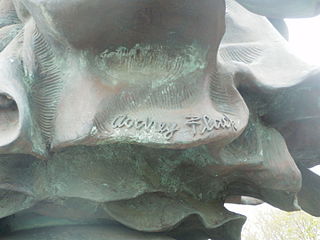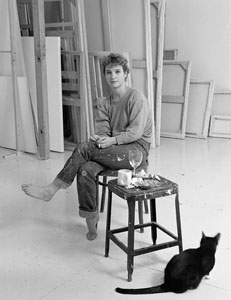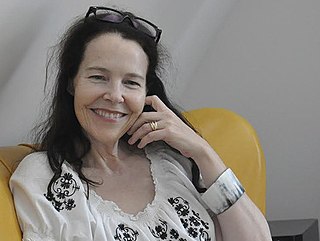
John Henry Twachtman was an American painter best known for his impressionist landscapes, though his painting style varied widely through his career. Art historians consider Twachtman's style of American Impressionism to be among the more personal and experimental of his generation. He was a member of "The Ten", a loosely allied group of American artists dissatisfied with professional art organizations, who banded together in 1898 to exhibit their works as a stylistically unified group.

Julie Mehretu is an American contemporary visual artist, known for her multi-layered paintings of abstracted landscapes on a large scale. Her paintings, drawings, and prints depict the cumulative effects of urban sociopolitical changes.

Gwendolyn Clarine Knight was an American artist who was born in Bridgetown, Barbados, in the West Indies.

Audrey L. Flack is an American artist. Her work pioneered the art genre of photorealism; her work encompasses painting, sculpture, and photography.
Diane Katsiaficas is an American visual artist of Greek heritage. Her work ranges from small journal drawings and paintings to large-scale installations and has been shown throughout the United States and Europe. She is a professor in the Art Department at the University of Minnesota.
Harmony Hammond is an American artist, activist, curator, and writer. She was a prominent figure in the founding of the feminist art movement in 1970's New York.

Louisa Lizbeth Chase was an American neo-expressionist painter and printmaker.
Jacqueline "Jackie" Winsor is a Canadian-American sculptor. Her style, which developed in the early 1970s as a reaction to the work of minimal artists, has been characterized as post-minimal, anti-form, and process art. Informed by her own personal history, Winsor's sculptures from this period sit at the intersection of Minimalism and feminism, maintaining an attention to elementary geometry and symmetrical form while eschewing Minimalism's reliance on industrial materials and methods through the incorporation of hand-crafted, organic materials such as wood and hemp.
Laylah Ali (born 1968, Buffalo, New York) is a contemporary visual artist known for paintings in which ambiguous race relations are depicted with a graphic clarity and cartoon strip format.
Lisa Lapinski is an American visual artist who creates dense, formally complex sculptures which utilize both the language of traditional craft and advanced semiotics. Her uncanny objects interrogate the production of desire and the exchange of meaning in an image-based society. Discussing a group show in 2007, New York Times Art Writer Holland Cotter noted, "An installation by Lisa Lapinski carries a hefty theory- studies title: 'Christmas Tea-Meeting, Presented by Dialogue and Humanism, Formerly Dialectics and Humanism.' But the piece itself just looks breezily enigmatic." It is often remarked that viewers of Lapinski's sculptures are enticed into an elaborate set of ritualistic decodings. In a review of her work published in ArtForum, Michael Ned Holte noted, "At such moments, it becomes clear that Lapinski's entire systemic logic is less circular than accumulative: What at first seems hermetically sealed is often surprisingly generous upon sustained investigation." Lapinski's work has been exhibited widely in the US and Europe, and she was included in the 2006 Whitney Biennial.
Gershon Benjamin was an American modern painter. Born in Piatra Neamț, Romania, he immigrated with his family to Montreal at the age of two, to escape the persecution of Jews throughout Eastern Europe at the time. As a youth he was trained by Edmond Dyonnet and then mentored by landscape painter Arthur-Dominique Rozaire, whom he intended to follow to Los Angeles but his parents forbid it.
Harriet Bart is a Minneapolis based conceptual artist, known for her objects, installations, and artists books.

Angela Ellsworth is a multidisciplinary American artist traversing disciplines of drawing, sculpture, installation, video, and performance. Her solo and collaborative works have addressed wide-ranging subjects such as physical fitness, endurance, illness, social ritual, and religious tradition. She is interested in art merging with everyday life and public and private experiences colliding in unexpected places. She is a descendant of LDS prophet Lorenzo Snow and was raised as a Mormon; some of her work relates to her religious upbringing. She is openly queer and married to writer/ performer Tania Katan.
Dyani White Hawk is a contemporary artist and curator of Sicangu Lakota, German, and Welsh ancestry based out of Minnesota. From 2010 to 2015, White Hawk was a curator for the Minneapolis gallery All My Relations. As an artist, White Hawk's work aesthetic is characterized by a combination of modern abstract painting and traditional Lakota art. White Hawk's pieces reflect both her Western, American upbringing and her indigenous ancestors mediums and modes for creating visual art.
Elizabeth Erickson is an American painter, feminist artist, poet, and educator. Her style of painting tends to gestural abstraction and the themes she explores occupy "the territories of ancient myth, religion, and spiritual feminism".
Jantje Visscher is an American painter, printmaker, photographer, sculptor, teacher and mentor. Visscher uses geometry and mathematics to explore the dynamics of perception and optical effects through the use of nontraditional mixed media. She is based in Minneapolis, MN and is currently active among the WARM Mentor Program and the Traffic Zone Center for Visual Art. Visscher is best known for hard edge abstraction and minimalism within her scientific approach and exploration of perception and mathematics.
Liza Sylvestre is an American visual artist born and raised in Minneapolis, Minnesota. She is known for detailed abstract mixed media paintings and drawings. Her current work explores new media such as installation and video art. Much of her work revolves around our sensory perceptions and misconceptions of the world around.
Maria Cristina Tavera ("Tina") is a contemporary Latinx artist, curator, and cultural organizer who lives and works in Minneapolis, MN. Influenced by her dual citizenship, as well as her transnational movement between her residing Minnesota and Mexico families, she combines historical and contemporary texts and images from recognizable Latin American myths, legends, and present news. Tavera uses her prints, paintings, installations, and Dia de los Muertos ofrendas, or altars, to explore the way that national and cultural icons symbolize complex identities and can construct shared communities at home and abroad. Her artwork is both humorous and confrontational as she invites her viewers to question constructs of race, gender, ethnicity and national and cultural identities. She has exhibited her artwork and curated shows all around the world, and has artworks permanently installed in several art exhibits throughout Minnesota.
Julie Buffalohead is a contemporary Indigenous American artist. Her work mainly focuses on themes of racial injustice, indigenous rights, and abuse of power.






